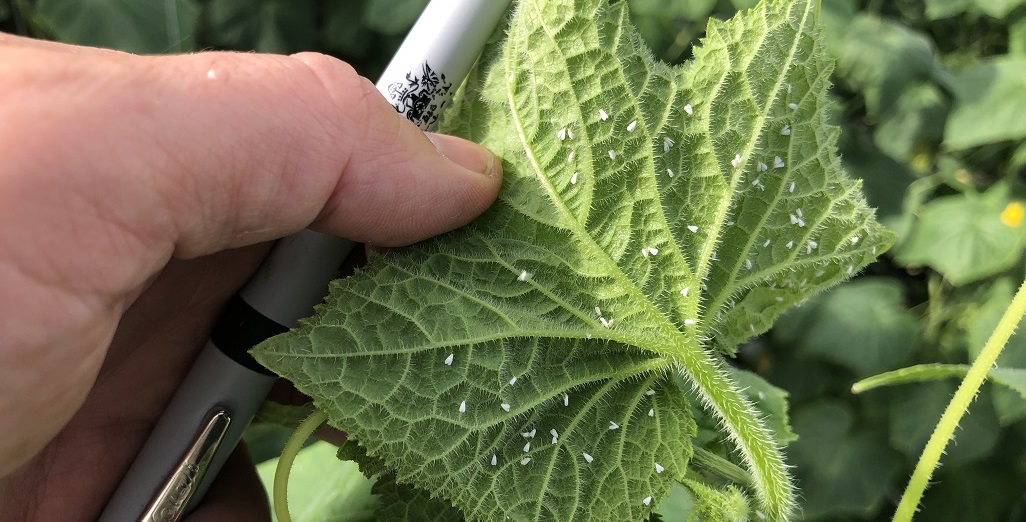Sign up here to subscribe to the Grower2grower Ezine. Every two weeks you will receive new articles, specific to the protected cropping industry, informing you of industry news and events straight to your inbox.
Oct 2018
Aphids kick off insect season!!

Reproducing at an alarming rate
Last edition I wrote an article regarding spray damage in relation to increasing pest numbers. I understand it is always insect season, the winter is still a challenge to control pests, but the pressure will ramp up now we are in spring and the weather is improving. Late last week I was notified Aphids had started multiplying rapidly in a greenhouse cucumber crop in the South Auckland region. The weather in September has been good, I expect it has helped the sudden influx of Aphids, which I don’t recall seeing this soon after winter in NZ. Nor have I seen them spread so quickly. The immediate response was to spray a selective insecticide, which I agreed was the correct decision in this case, however biological options are available.
When I worked in an organic greenhouse production site in the UK Aphids were a major problem for cucumber plants. The introduction of large numbers of Aphidius (a natural predator), managing aphid populations, with the addition of organic sprays, worked to good effect. Natural pyrethrums were the organic spray of choice (you may like to read this article regarding pyrethrums https://www.todayshomeowner.com/is-pyrethrum-a-safe-organic-pesticide/ “Pyrethrum refers to the Pyrethrum daisy (Chrysanthemum cinerariifolium) from which the insecticidal compound is extracted. Also nicknamed Dalmatian chrysanthemum, this perennial daisy is loaded with chemicals called pyrethrins that are toxic to insects. Since it is directly extracted from a plant, and since it is considered nontoxic to humans, pyrethrum is approved in the U.S. for use on certified organic farms” Quote from article written by Julie Day.) (On a side note I am going to crush some daisy’s up to see if it works ��)
With most pests, early identification is your best chance of defence and to limit your insecticide applications. If you need to use an insecticide to control pests, I would then talk to your bio-control supplier about the possibility of introducing Aphidius, if it is available. Just let them know what and when you have sprayed so they can advise on the appropriate time to introduce the Aphidius if possible. You might find it gives you good control for a long period of time or short, but at least it gives you an option to not spray. Please don’t hesitate, if the beneficial predators are not keeping up, to then use either an insecticide or biological spray to reduce pest numbers.
There will be other insecticide options that your local wholesaler will have. Talk to their experts, and if you do intend to use in combination a biological option see if there is a product available that would be less harmful to a beneficial predator.
There is a low demand for Aphidius currently in NZ and if someone wants them it does take time to produce enough numbers to then have enough time to colonises an Aphid colony. With Capsicums especially, you often don’t have enough time for the Aphidius to gain control before you potentially loose the head from the damage the Aphid causes. This is where a knockdown with an insecticide and then introducing Aphidius will finish the job.
Pictures taken above (top cover photo) are from the greenhouse in South Auckland taken last week. It was over an extremely short period of time that the pests were first noticed until they reproduced in huge numbers. Hence it is very hard to gain immediate control if suddenly introducing a biological predator.
Aphids are a big problem in the horticultural sector. Through their enormous reproductive capability, aphids can cause severe damage to several crops. Resistance to pesticides is increasing. Important aphids occurring in glasshouses are: the cotton aphid Aphis gossypii, the glasshouse potato aphid Aulacorthum solani, the potato aphid Macrosiphum euphorbiae and the green peach aphid Myzus persicae.
Biology
In glasshouses aphid population always consists of viviparous females. Young aphids are born and immediately start feeding on plant sap. They grow quickly and moult four times before they become adult. The resulting characteristic white skins betray the presence of aphids. Winged aphids develop at high densities, enabling rapid spread through the glasshouse from hot spot areas.
Symptoms: Nymphs and adults feed on plant sap. This halts growth, causing curled leaves. Sometimes yellow spots appear. Aphids excrete honeydew. Sooty moulds can develop on this, soiling the crop. Photosynthesis reduces, and consequently growth and production.
Toxic substances can be brought into the plant, causing strong allergic reactions in the plant.
Plant pathogenic substances, particularly viruses, can be brought into the plant. (Extract from the Zonda website, click here to read more)
I appreciate your comments. Please feel free to comment below or on the grower2grower Facebook page:
https://www.facebook.com/StefanGrower2grower/
Article written by Stefan Vogrincic with inserts from Zonda Beneficials and Writer Julie Day.
CLASSIFIED
Subscribe to our E-Zine
More
From This Category

Starting on the back foot

(Best of 2023) RNA-based disease control in protected cropping environments. Anne Sawyer presents at the PCA Conference (Best new development PCA 2023)

(Best of 2023) Aphid infestation on cucumber crops

LimoMax, a new predator for insect control in greenhouses and outdoor crops.

Aphid infestation on cucumber crops

























